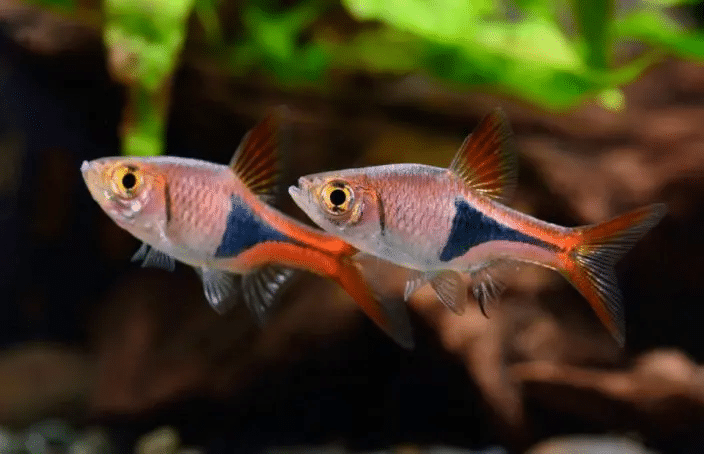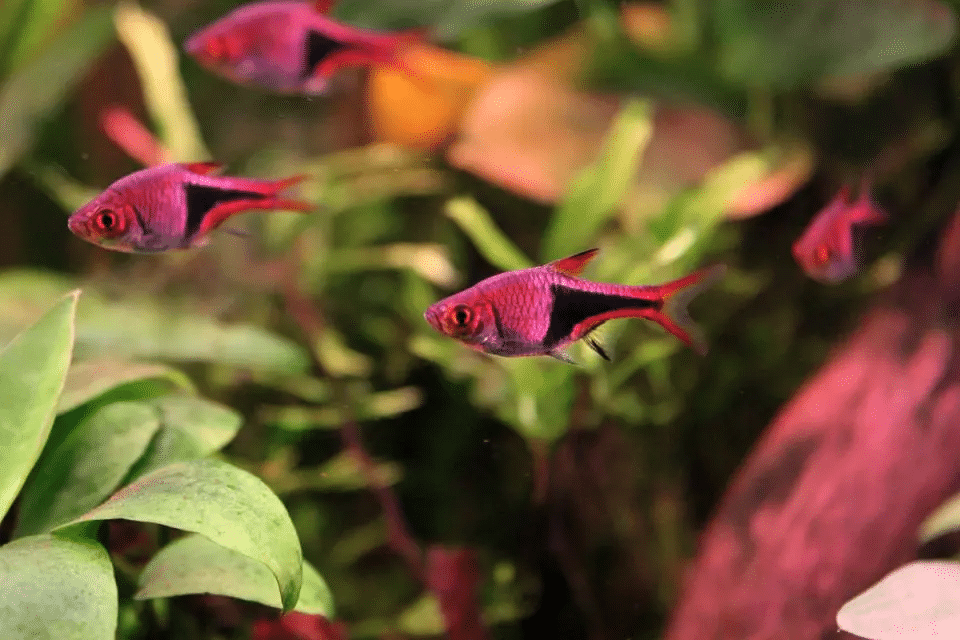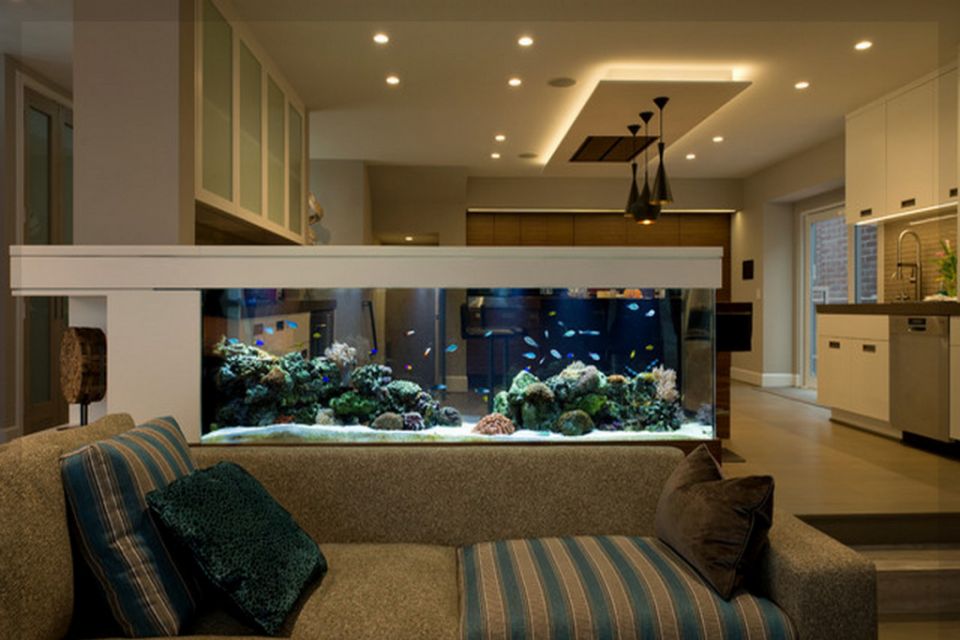
The small wedge-tailed rasbora, lat.: Trigonostigma heteromorpha, is a popular aquarium fish from Southeast Asia. It belongs to the family of bearblings, grows up to 5 centimetres long and has a high-backed, narrow body. The wedge-shaped spot on the side of the shy fish is both striking and eponymous. The holistic colouring of the animal varies from pink to reddish and copper.
Particularly striking are its large, shiny metallic scales. The Harlequin rasbora is not only beautiful to look at, but also extremely robust and peace-loving, which is why it is often kept in aquarium.
Nevertheless, there are some things to consider when keeping the little fish to ensure the best possible quality of life. Important topics around the suitable aquarium, the keeping, breeding as well as the ideal water conditions for the Harlequin rasbora you can find out in the following aquaristic guide article.
Table of Contents
Everything important about Harlequin rasbora in a nutshell
- Trigonostigma heteromorpha is considered easy to keep in the aquarium and is therefore especially suitable for beginners
- A jellyfish should always be kept in a group of at least eight animals
- It is essential that the typical water values of its home area are respected
- Males and females reach a size of up to five centimetres, with males being considerably slimmer
- In Southeast-Asia, the Harlequin rasboraprefers peaty and turbid waters with mainly soft water
- In terms of colouring, the wedge-spotted darling varies from a light rosé tone to a deep red copper
- The black wedge pulls itself with males up to the tail fluke, with females this already ends before the fin
- Harlequin rasborahave extremely large scales compared to other ornamental fish, which give off a metallic sheen
- Trigonostigma heteromorpha thrives in the company of its conspecifics, but can also be kept with various catfish species and other livebearers without problems
- As an omnivore, a wedge-bearling can be fed with both plant and animal products
- The fish are preferably bred in species aquariums, because they give birth alive

Where do the Harlequin rasboras occur?
Trigonostigma heteromorpha originally comes from South East Asia. Its habitat extends over the entire peninsula of Malaysia as well as Singapore and the southeast of Thailand. The Indonesian island Sumatra is also home to the animal.
In the wild, the wedge-spotted rasbora prefers small, peaty and shady black water streams with predominantly soft water. The waters here usually have only a small current and are also extremely clear.

How many Harlequin rasbora keep in the aquarium?
Harlequin rasbora are not schooling fish, so small groups of eight or more are sufficient. Of course it is possible to keep much more animals in the aquarium, but the size of the aquarium must be considered accordingly.
Harlequin rasboras can already be kept in particularly small aquariums: an edge length of 60 centimetres, i.e. a standard 60 litre aquarium is already sufficient here. In this case, as mentioned above, a group of at least eight animals should be kept.
In aquariums from 180-240 liters, wedge-spotted bearblings can also be socialized with other bearblings or characins.

How to keep Harlequin rasboras in an aquarium?
Basically the keeping of Harlequin rasboraen is extremely easy and therefore also recommended for beginners in aquaristics. To ensure ideal living conditions, an aquarium of at least 60 litres is recommended. It should not be smaller, especially if there are other fish in the aquarium in addition to the Harlequin rasbora.
Preferred are dusky conditions: dark, sandy soils as well as a ceiling of fine-grained plants. The aquarium should therefore be equipped with sufficient floating plants and dense border planting, as the small fish like to lie down on plant leaves during bedtime. In addition, there should be enough room to swim under the plant cover. The animals prefer to stay in the middle water zone, so it is advantageous to place the decorations accordingly.

Particularly quiet areas are gratefully accepted by the shy wedge-spotted dolphin and contribute to an improved sense of well-being. Peat filtering is also recommended due to its origin. Otherwise there is the possibility to refine the water with peat extract. Although it is not absolutely necessary, it increases the well-being of the animals.
Decorative objects such as bogwood roots or stones are also popular hiding places for the Harlequin rasboras and are an excellent match for the natural habitat of Trigonostigma heteromorpha.

Which water values does a wedge-spotted darter prefer?
The habitat of the animals should be imitated as much as possible. This can also be seen in the following water values:
- Aquarium: at least 60 litres
- Water temperature: 22° C – 28° C
- pH value: 5 – 7
- Total hardness: 2° – 15° dGH
Especially important for a wedge-bearling is warm water with a low lime content and temperatures up to 28° C. As long as the tap water is not calcareous, this condition is basically achieved in this way.
A sufficient oxygen supply is particularly important. If you want to keep Harlequin rasbora, you should always provide sufficient oxygen in the aquarium, during the day as well as at night.
With a pH value of up to 7, the water should be slightly acidic. A wedge-spotted darter is most likely to tolerate a water hardness between 2° and 15° dGH. If possible, this zone should not be exceeded. Harlequin rasboras originally live in soft water, so the natural habitat should be recreated as much as possible.

Association of Trigonostigma heteromorpha
The Harlequin rasbora are peace-loving by nature and can therefore easily be socialized with other barbels, as long as they fit together well. Armoured catfish, pygmy catfish, Ember tetra or red neon are particularly suitable for socialisation. But also with livebearers such as guppies and other platys, a wedge-tailed barbel can be kept without problems.
However, shoaling fish that are in the upper half of the tank should not be kept together with a wedge-spotted bear. On the other hand, it makes friends relatively quickly with peace-loving fish in the lower half of the tank. In addition, care should always be taken to ensure that the other animals are also suitable for soft water.
However, it is not recommended to keep crayfish, as sleeping bear crayfish are a found food.

What does a brown rasbora eat?
This striking fish species is an omnivore, which is why they are fed on both animal and vegetable food. However, small live, flake and frozen food is preferred – by the way, you can find everything worth knowing about the different types of aquarium fish food in our large guidebook article. The small fish do not tolerate large meals, so they should receive several small portions daily. In addition, one diet day per week should be observed. For optimal health, a regular vitamin supply should also be included. If Trigonostigma heteromorpha are fed a varied and healthy diet, they can live up to seven years.

How are Harlequin rasboras bred?
In contrast to the keeping, the breeding of Trigonostigma heteromorpha proves to be rather demanding. In a community aquarium breeding of the animals is only possible to a limited extent, which is why this is basically only done in a species aquarium.
Already before the breeding it is important to pay attention to the correct water values. Good conditions for breeding are especially soft water and a pH-value below 7, ideally even a value of 5. However, this can hardly be achieved without a suitable osmosis plant, which is why a purchase is strongly recommended for breeding.
Also the planting as well as the overall temperature of the aquarium should be acceptable, as a wedge-bearling does not give birth alive but spawns. As the females spawn on the underside of the leaves of an aquatic plant, large-leaved plants such as water calyxes are recommended.
As soon as the eggs are laid, they are fertilized by the males. It is highly recommended that the pairs are only ever used individually for breeding. If the spawning is successful, the parents should be removed immediately, otherwise they will become spawn predators. For this reason it is important to observe the breeding process closely and to intervene in time.
The young hatch within a few days and can first be fed with fine dust food and infusoria.
Conclusion: Harlequin rasbora in the aquarium is easy
The keeping of Southeast Asian fish is basically not a big challenge for most aquarists. As long as the aquarium is kept dark, sufficient retreat places are created, the planting is sufficient and the ideal water values are available, the animals will feel particularly comfortable in their new home.
Also in the area of food intake the animals are not particularly difficult to keep. Whether animal or vegetable, flake food or small live food, a Harlequin rasbora is not choosy.
The animals can be socialized with numerous other fish species, as long as they can also live with these water values.
Only the breeding proves to be a little more complex, because a lot of attention is paid to the correct water quality. In addition, breeding should only be done with single pairs in species aquariums, as even parent animals tend to spawn.



